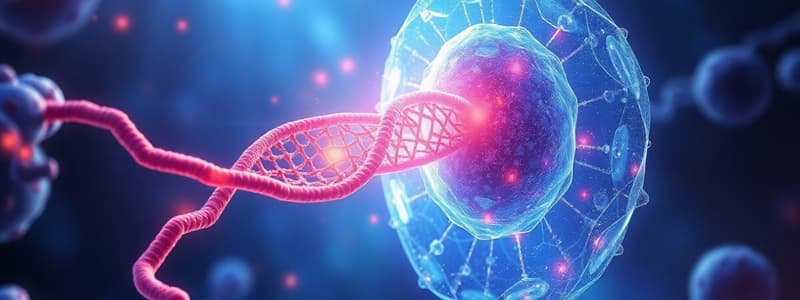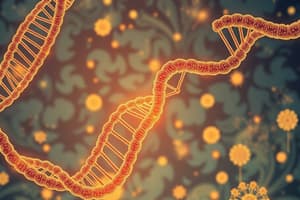Podcast
Questions and Answers
What structure is primarily responsible for cytokinesis in animal cells?
What structure is primarily responsible for cytokinesis in animal cells?
- Cell plate
- Golgi vesicles
- Contractile ring of actin and myosin filaments (correct)
- Origin of replication
Which of the following describes how cytokinesis occurs in plant cells?
Which of the following describes how cytokinesis occurs in plant cells?
- The cell membrane pinches inward forming a cleavage furrow.
- A cell plate is formed by vesicles from the Golgi apparatus (correct)
- The cell plate is formed from the plasma membrane directly
- A contractile ring of proteins separates the cell
What is the first step of binary fission?
What is the first step of binary fission?
- The two copies of DNA move to opposite ends of the cell
- The cell wall forms a divider.
- The plasma membrane pinches inward.
- The circular chromosome replicates, starting at the origin of replication. (correct)
Which process is believed to be the evolutionary precursor to mitosis?
Which process is believed to be the evolutionary precursor to mitosis?
What is a key difference between bacterial binary fission and eukaryotic mitosis?
What is a key difference between bacterial binary fission and eukaryotic mitosis?
What is the primary difference in the organization of DNA between prokaryotic and eukaryotic cells?
What is the primary difference in the organization of DNA between prokaryotic and eukaryotic cells?
Which phase of the cell cycle is specifically dedicated to DNA replication?
Which phase of the cell cycle is specifically dedicated to DNA replication?
During which stage of mitosis do sister chromatids separate and move towards opposite poles of the cell?
During which stage of mitosis do sister chromatids separate and move towards opposite poles of the cell?
What are the structures on chromosomes that spindle fibers attach to during prometaphase?
What are the structures on chromosomes that spindle fibers attach to during prometaphase?
Which of the following best describes the role of non-kinetochore microtubules during mitosis?
Which of the following best describes the role of non-kinetochore microtubules during mitosis?
If a cell leaves the cell cycle and enters a non-dividing stage, this stage is referred to as:
If a cell leaves the cell cycle and enters a non-dividing stage, this stage is referred to as:
Which of the following structures are responsible for organizing microtubules during mitosis?
Which of the following structures are responsible for organizing microtubules during mitosis?
During which phase of mitosis does the nuclear envelope completely fragment?
During which phase of mitosis does the nuclear envelope completely fragment?
Flashcards
Cell Division
Cell Division
The process by which a cell divides into two daughter cells.
Cytokinesis
Cytokinesis
The division of the cytoplasm in eukaryotic cells.
Binary Fission
Binary Fission
The process of cell division in prokaryotes, such as bacteria.
Cell Plate
Cell Plate
Signup and view all the flashcards
Evolution of Mitosis
Evolution of Mitosis
Signup and view all the flashcards
Nucleoid
Nucleoid
Signup and view all the flashcards
Plasmids
Plasmids
Signup and view all the flashcards
DNA Replication
DNA Replication
Signup and view all the flashcards
Interphase
Interphase
Signup and view all the flashcards
M Phase (Mitotic Phase)
M Phase (Mitotic Phase)
Signup and view all the flashcards
Prophase
Prophase
Signup and view all the flashcards
Metaphase
Metaphase
Signup and view all the flashcards
Anaphase
Anaphase
Signup and view all the flashcards
Study Notes
Prokaryotic Genome Structure
- Prokaryotes have a single, circular chromosome located in the nucleoid region.
- They lack a membrane-bound nucleus.
- DNA is compacted by supercoiling and proteins, not histones.
- Plasmids, small independent DNA molecules, may also be present.
Eukaryotic Genome Structure
- Eukaryotic genomes consist of multiple linear chromosomes enclosed within a nucleus.
- Chromosomes are associated with histones to form chromatin.
- The DNA structure is highly organized and changes throughout the cell cycle.
- Non-coding DNA, including introns and regulatory sequences, and repetitive elements are present.
Cell Cycle Phases
- Interphase (90%):
- G1 Phase: Cell growth, normal function, protein and organelle synthesis, preparation for DNA replication.
- S Phase: DNA replication, formation of sister chromatids.
- G2 Phase: Cell prepares for mitosis, synthesis of microtubules and proteins, DNA error checking, organelle duplication.
- M (Mitotic) Phase: Mitosis (nuclear division) and cytokinesis (cytoplasmic division).
- G0 Phase: Quiescent stage, cell exits cycle, non-dividing cells.
Mitosis Phases
- Prophase: Chromatin condenses, mitotic spindle forms, nuclear envelope breaks down.
- Prometaphase: Nuclear envelope fragments, spindle fibers attach to kinetochores.
- Metaphase: Chromosomes align at the metaphase plate, spindle fibers are fully formed.
- Anaphase: Sister chromatids separate, kinetochore microtubules shorten, non-kinetochore microtubules elongate the cell.
- Telophase: Chromosomes decondense, nuclear envelopes reform, spindle fibers disassemble.
Mitotic Spindle Structure
- Centrosomes: Microtubule-organizing centers forming spindle poles.
- Kinetochore Microtubules: Attach to kinetochores, pull chromosomes in anaphase.
- Non-Kinetochore Microtubules: Overlap, push against each other, elongate the cell.
- Asters: Short microtubules radiating from centrosomes, anchoring them to the plasma membrane.
Cytokinesis Differences (Animals vs. Plants)
- Animals: Cleavage furrow (actin and myosin filaments) forms, plasma membrane pinches inward.
- Plants: Cell plate forms in the middle of the cell. Vesicles from Golgi fuse to create the cell plate, which eventually becomes a new cell wall.
Binary Fission in Bacteria
-
Steps:
- Chromosomal replication at the origin of replication.
- Two DNA copies move to opposite ends.
- Inward pinching of the plasma membrane, formation of a new cell wall.
-
Evolutionary Perspective: Binary fission is the ancestral process for mitosis. Protein similarities exist between bacterial chromosome segregation and mitotic spindle proteins. Complexity increased in eukaryotes with linear chromosomes and a nuclear envelope.
Studying That Suits You
Use AI to generate personalized quizzes and flashcards to suit your learning preferences.
Description
This quiz covers the fundamental differences between prokaryotic and eukaryotic genome structures, including chromosome organization and DNA packaging. It also explores the phases of the cell cycle and the key processes that occur during each phase, providing a comprehensive overview of cellular biology.




